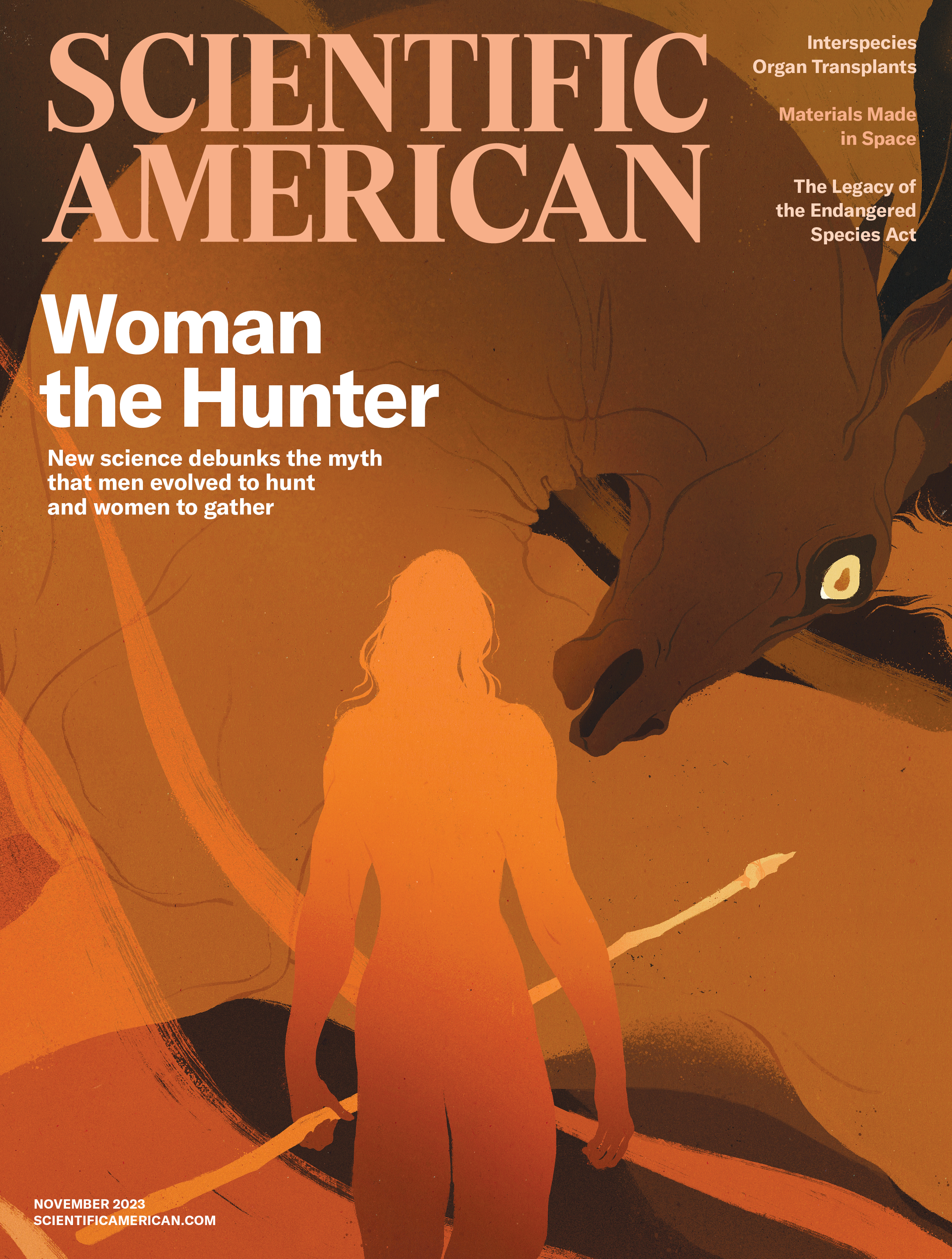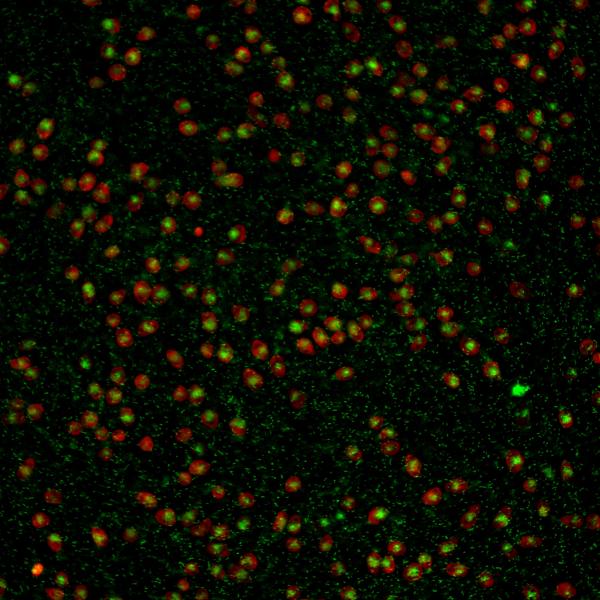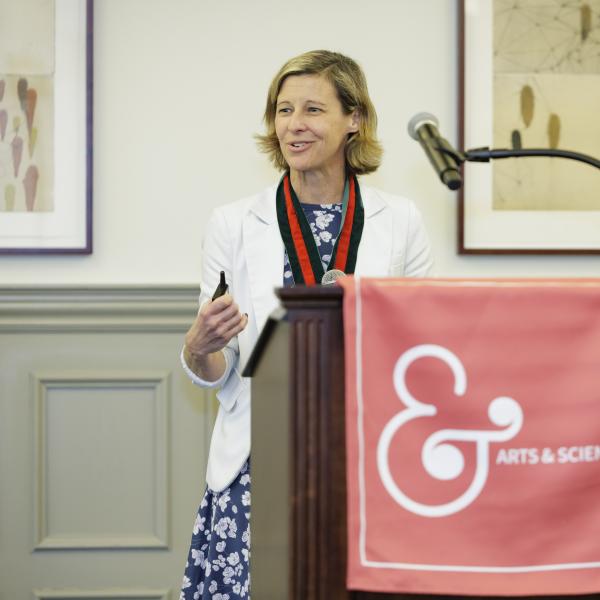A Scientific American cover story by anthropology alumnae Cara Ocobock and Sarah Lacy, both PhD ’14, shows the power of collaboration, then and now.

(Image courtesy of Scientific American)
An early human hurls a spear at an antelope and tracks the wounded animal across the African savanna. Do you have a clear picture of the hunter in mind?
Perhaps she’s not exactly what you imagined.
For the last few years, Department of Anthropology alumnae Cara Ocobock, PhD ’14, and Sarah Lacy, PhD ’14, have been working together to shatter the oversimplified myth that hunting in early societies was strictly a man’s job. “Early hunter-gatherer societies were all hands on deck,” Ocobock said. “There was no deep division of labor in our evolutionary past. Women certainly did a fair share of the hunting.”
Their project, “Woman the Hunter,” combines archeological and physiologic data for a fuller picture of early human survival. It didn’t take long for it to generate significant buzz in the anthropology world. “When we presented it at an annual conference, they had to bring in extra rows of chairs,” Lacy said. An article they wrote on the topic even made the cover of the November 2023 issue of Scientific American, another achievement in a collaboration nearly a decade in the making.
Ocobock, now an assistant professor of anthropology at the University of Notre Dame, and Lacy, now an assistant professor of anthropology at the University of Delaware, went their separate ways after graduating from WashU, but their friendship and shared interests kept their collaboration alive.
In 2021, they co-authored a review article that explored how Neanderthals withstood the Ice Age climate of Europe tens of thousands of years ago. “There was a widespread acknowledgment that Neanderthals were well-adapted to the cold, but nobody had really brought all of the evidence together to explain how,” Lacy said.
Neanderthals had plenty of animal furs for warmth and stout bodies that could endure cold, but Ocobock and Lacy concluded that our early relatives survived by working together. It’s likely that all members of a group pitched in however they could, whether that meant tending a fire, carrying a child, or throwing a spear.
Their work on Neanderthals inspired Ocobock and Lacy to take on the stereotype of “man the hunter,” a trope that permeates popular culture as well as science. Evidence against the stereotype had been mounting for decades, but no one had gathered the threads to create a more complete picture of cooperation between early men and women. “We thought it was time,” Lacy said.
In their Scientific American piece, Ocobock and Lacy detail the physiologic attributes that gave women an edge in the pursuit of animals. For example, women’s bodies generally have more fat stores and a higher proportion of “slow-twitch” muscle fibers, traits that can make them especially well-equipped to follow an animal over long distances or tackle other high-endurance tasks. Ocobock and Lacy note that modern women excel at ultramarathons and other endurance trials. English runner Sophie Power even ran the 105-mile Ultra-Trail du Mont-Blanc race while breastfeeding her three-month-old at rest stations, they wrote.

The scholars also shared modern and ancient examples of women bringing in meat for their families and villages. For example, female members of the indigenous Ainu people of northern Japan traditionally hunted deer and other prey with the help of dogs, a fact that past anthropologists largely ignored or dismissed. Ocobock and Lacy acknowledge that while men do most — if not all — of the hunting in many modern hunter-gatherer communities, that’s partly because they have absorbed modern gender norms.
Even now, they said, some scientists claim that men evolved certain physical traits — strong biceps, for example— because they needed those attributes to hunt. But it would be a mistake to say that modern humans owe any of their abilities solely to the exploits of early hunters, Ocobock said. “We don’t think that hunting was a major driver of human evolution,” she said. After all, she said, meat was just one part of the diet, and humans had plenty of other reasons to develop the brains and bodies that make us who we are.
Both Ocobock and Lacy said their WashU training left them well-prepared to take on big questions in anthropology. They were friends in grad school, but their work didn’t closely overlap. Ocobock studied participants in the National Outdoor Leadership School in Colorado’s Rocky Mountains to learn about the energy expenditures of active people at high altitudes. Lacy studied the teeth and bones of Neanderthals and other early hominins to better understand their lifestyles and diets.
Despite their disparate interests, Ocobock and Lacy shared a WashU mentor: Erik Trinkaus, now a professor emeritus of physical anthropology. “He mentored us in exactly the way that we needed,” Lacy said. “We both ended up with tenure-track positions immediately after graduate school, which is unusual, and it’s largely thanks to him.”
“WashU was a very collegial environment,” Ocobock said. “Our cohort was very close-knit and solidly connected.” The pair are now at other institutions, but they’ve kept that spirit of teamwork alive. As our ancestors could attest, people can’t accomplish much alone.



